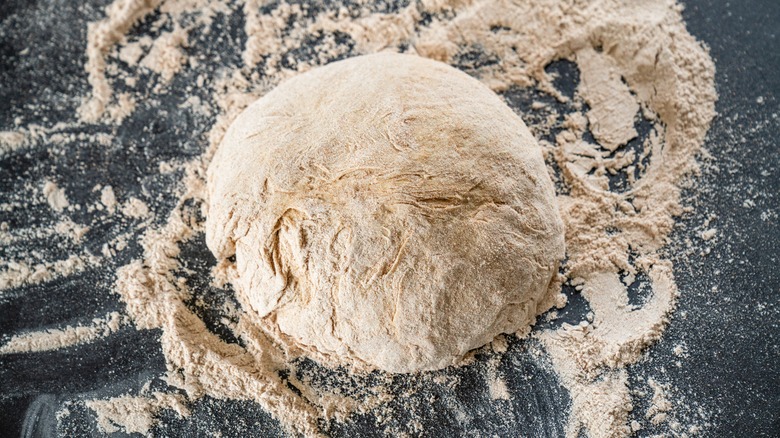How To Flour Your Countertop As Evenly As Possible
Experienced bakers know that evenly dusting your countertop with flour prevents dough from sticking to the surface, whether you're making the best basic scone recipe or chocolate soufflé tartlets with salted caramel. When you execute such an important step, it's vital that you get it right. Use too little flour, and bits of dough will peel off or the whole mass gets stuck to the work surface. Too much, and you end up incorporating extra flour, making your dough tough and dry.
When you dust flour by hand, it's important to make the "cloud" of powder as wide as possible as it hits the countertop. Place a heavy pinch in the palm of your hand and press your fingertips together in a sort of "chef's kiss" hand position. Keep the back of your hand towards the tabletop, gently spread your knuckles, and toss the flour at the surface in a hook-shaped motion. The goal is for the flour to sift through the gaps in your fingers and evenly spread across the counter, a bit like using an extra-large, impromptu shaker.
This method is so efficient because it increases the surface area you can cover with flour, by creating multiple holes for the powder to flow through. It's a great way to ensure that no portion of your work surface becomes too heavily or lightly coated. With a bit of experience and experimentation, you can also find other ways to ensure your dough won't stick to your work surface.
Other ways to evenly flour your countertop
When using this "shaker" dusting method, you can adjust how much flour you throw at once by tweaking the strength of your movement. Throwing in quick, jerking motions creates a small cloud that evenly disperses over a wider area. If you notice one spot on your counter hasn't got much flour, you can throw more at the area slowly and gently, releasing a more dense stream directly onto the desired zone.
If you aren't ready to tackle the knuckle-sifter method, try a classic snap and jerk motion. Take a palmful of flour in a gentle grip, hold your fist facing up (parallel to the counter), and move your hand in a snapping motion toward the area you want to dust. About 10 or 12 inches away from the designated spot, you'll open your hand and jerk your arm back. This scatters the flour in a relatively even layer, while still covering a wide area.
If you or someone you're cooking for avoids gluten, feel free to substitute wheat flour with starches like corn, arrowroot, or potato, or just use gluten-free flour. Just keep in mind that these ingredients can affect how food cooks, so research how they might interact with your dishes. Depending on your recipe, you can forgo flour altogether and try Alton Brown's countertop hack for sweeter sugar cookies: use confectioner's sugar. The idea behind flour dusting is to provide a buffer between the moist dough and dry work surface, and powdered sugar does this well while adding extra sweetness.


